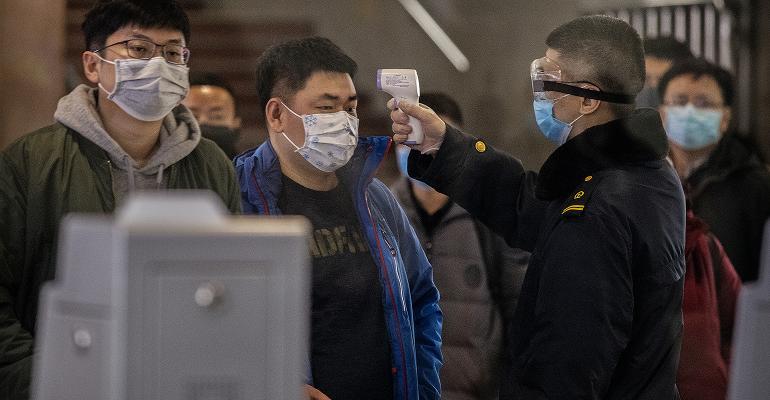(Bloomberg) -- The price of safety has rarely looked so high across major asset classes. Confronted with the coronavirus, investors seem more than willing to pay it.
U.S. Treasuries are trading close to their most expensive in history by at least one measure, while gold hit a seven-year high on Monday. The entire German yield curve dropped below zero the same day.
Yet with the economic and human toll of the virus growing daily and spreading outside China, few see the recent demand for havens ebbing. The outbreak has now spilled into countries like Italy and Iran, with the prospect of severe government measures to contain the spread -- especially in Europe -- raising worries over the ultimate hit to global growth.
“It’s become more frightening,” said Laurent Tignard, head of multi asset institutional solutions at Amundi SA in Paris, who’s using long-dated bonds to hedge global economic risks. “We still expect a V-shaped recovery, but there is a risk that a rebound in the second, third and fourth quarters might not be strong enough to compensate a steep losses in the first quarter. It’s probably too early to start taking in more risk assets.”
Amundi has a neutral stance on bonds even as term premium, one measure used as a valuation tool, stands at minus 1.12 percentage points for 10-year Treasuries. That’s not far off its record low. The gauge, which is the extra compensation investors require to hold longer-maturity debt versus just rolling over shorter-dated obligations, has historically been positive.
The slide in Treasury yields this week has made U.S. debt as expensive versus true-value models as anytime in the past two years.
Gold Run
The team of multi-asset strategists at HSBC Bank Plc suggested this week that investors stay overweight both government bonds and gold. That’s even as the metal touched the most expensive since 2013.
Gold was down 0.5% to $1,651.23 per ounce as of 9:16 a.m. in New York, but the trend has been clear in 2020. Exchange-traded funds increased gold holdings for 24 straight days through Monday, according to data compiled by Bloomberg. Bullion has entered overbought territory four times this year based on its relative strength index.
“U.S. real rates have plummeted during the virus scare,” said John Velis, FX and macro strategist at BNY Mellon Corp. “Since gold tends to trade inversely to real rates, the rally in gold will probably persist as long as the latter stay under pressure.”
America First
The number of coronavirus cases worldwide has now topped 80,000, prompting concern it will become a pandemic. Infections in South Korea, the worst-affected nation after China, rose to nearly 1,000 as the U.S., Japan and Hong Kong issued travel warnings to the country. China’s death toll rose by 71 to 2,663. In Europe, Italian cases jumped to 283 from 229.
It’s all driven demand for safety. The dollar, the top G-10 performer since the news of virus outbreak was made public, is the most overvalued major currency as it also benefits from haven flows toward the world’s biggest economy.
As uncertainty lingers, Barclays says haven assets can continue to enjoy support.
“In reality, we will not know whether Covid-19 could indeed be the straw that breaks this elongated economic cycles’ back for a few weeks yet,” said William Hobbs, the chief investment officer at Barclays Investment Solutions Ltd. “In the place of such data, rumors and speculation will try to fill the void as ever. This suggests that perceived safe havens across the asset class spectrum will continue to find plenty of support for now.”
--With assistance from Justina Lee, Ksenia Galouchko, Yakob Peterseil and Liz Capo McCormick.
To contact the reporter on this story:
Anchalee Worrachate in London at [email protected]
To contact the editors responsible for this story:
Sam Potter at [email protected]
Cecile Gutscher





